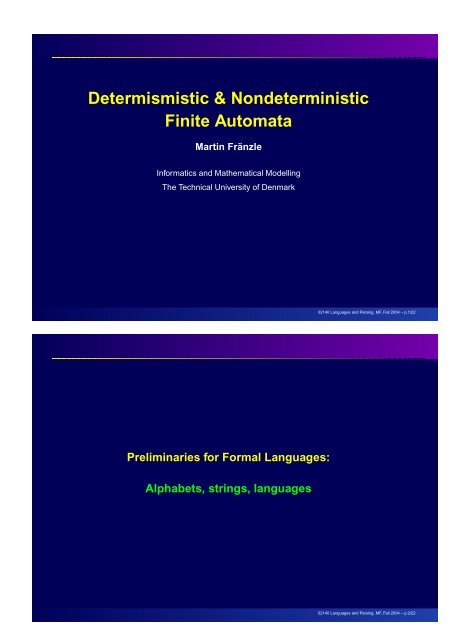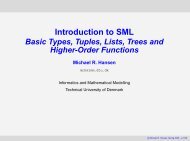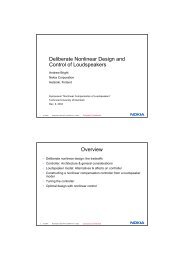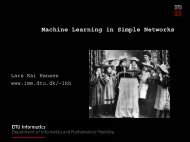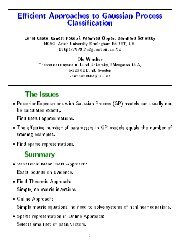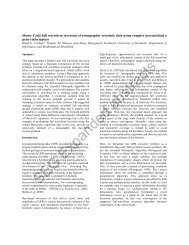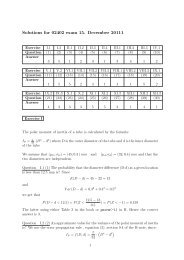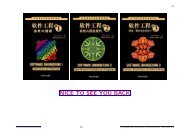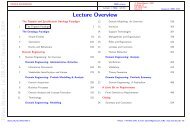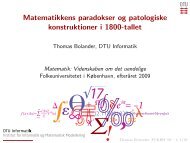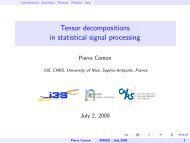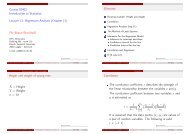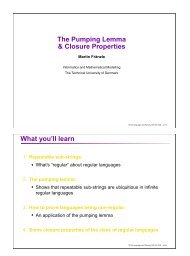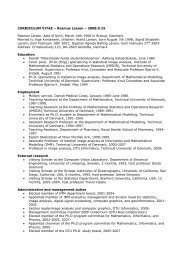Deterministic Finite Automata (DFA) Nondeterministic Finite Automata
Deterministic Finite Automata (DFA) Nondeterministic Finite Automata
Deterministic Finite Automata (DFA) Nondeterministic Finite Automata
Create successful ePaper yourself
Turn your PDF publications into a flip-book with our unique Google optimized e-Paper software.
Determismistic & <strong>Nondeterministic</strong><br />
<strong>Finite</strong> <strong>Automata</strong><br />
Martin Fränzle<br />
Informatics and Mathematical Modelling<br />
The Technical University of Denmark<br />
02140 Languages and Parsing, MF, Fall 2004 – p.1/22<br />
Preliminaries for Formal Languages:<br />
Alphabets, strings, languages<br />
02140 Languages and Parsing, MF, Fall 2004 – p.2/22
£<br />
¤<br />
£ ¢<br />
¡<br />
£<br />
What you’ll learn<br />
You will be introduced to the basic notions of<br />
Alphabet: A set of “symbols”,<br />
String/word: a sequence of symbols from the alphabet,<br />
Language: a set of strings.<br />
02140 Languages and Parsing, MF, Fall 2004 – p.3/22<br />
Alphabets<br />
Def.: An alphabet is a finite, nonempty set.<br />
Ex.:<br />
The binary alphabet ¥,<br />
the set of all printable ASCII characters,<br />
the set<br />
¡red<br />
£green £blue<br />
yellow £magenta cyan<br />
¥of basic colors.<br />
N.B.: This notion of alphabet is distinctly different from everyday use:<br />
alphabets need not feature an ordering,<br />
the members of an alphabet need not be letters in the usual<br />
sense, but can well be compounds of some kind (e.g.,<br />
tuples).<br />
We will often denote alphabets by the greek letter<br />
¦.<br />
02140 Languages and Parsing, MF, Fall 2004 – p.4/22
§<br />
<br />
<br />
<br />
<br />
<br />
<br />
§<br />
<br />
§<br />
<br />
£<br />
<br />
<br />
<br />
¦<br />
¡<br />
§<br />
¨<br />
¢<br />
£<br />
¤<br />
©<br />
<br />
<br />
§<br />
<br />
§<br />
<br />
<br />
<br />
¢<br />
¤<br />
¢<br />
£ ¢<br />
£ ¢<br />
¢ £<br />
¤ ¢<br />
© <br />
<br />
¡<br />
£ <br />
¥ <br />
<br />
<br />
<br />
<br />
<br />
<br />
<br />
§<br />
§<br />
<br />
<br />
§<br />
<br />
<br />
¦<br />
<br />
<br />
¦<br />
<br />
<br />
<br />
<br />
<br />
'<br />
<br />
¦<br />
!<br />
&<br />
<br />
<br />
%<br />
<br />
<br />
<br />
<br />
<br />
<br />
<br />
<br />
<br />
<br />
<br />
<br />
<br />
<br />
<br />
<br />
<br />
<br />
<br />
<br />
<br />
<br />
¦<br />
§<br />
<br />
¦<br />
<br />
<br />
<br />
<br />
<br />
<br />
¦<br />
¦<br />
<br />
<br />
<br />
'<br />
¦<br />
&<br />
%<br />
<br />
<br />
$<br />
¦<br />
¦<br />
<br />
<br />
¦<br />
Strings (a.k.a. words)<br />
Def.: A string (or word) over an Alphabet<br />
symbols from ¦.<br />
Ex.:<br />
The length of a string §, denoted<br />
for symbols in the string.<br />
is a finite sequence of<br />
¨, is the number of positions<br />
(or, more formally, ) is a string of length 4 over alphabet<br />
¥.<br />
is the string of length 0 over alphabet (as well as over any<br />
other alphabet). It is called the empty string and is generically denoted<br />
, irrespective of the particular alphabet.<br />
Def.: Given strings<br />
the concatenation of<br />
of length<br />
.<br />
def<br />
and<br />
and<br />
is the string<br />
,<br />
02140 Languages and Parsing, MF, Fall 2004 – p.5/22<br />
Powers of an alphabet<br />
Given an alphabet<br />
over<br />
and a natural number<br />
is the set of all strings over<br />
def<br />
def<br />
¦,<br />
"!<br />
#<br />
of length<br />
N,<br />
,<br />
is the set of all nonempty strings<br />
is the set of all strings over<br />
¦.<br />
02140 Languages and Parsing, MF, Fall 2004 – p.6/22
* 5<br />
¥<br />
<br />
¡<br />
6<br />
¥<br />
¦<br />
)<br />
<br />
(<br />
§<br />
,<br />
3<br />
+<br />
=<br />
¤<br />
¥ <<br />
(<br />
+<br />
3<br />
£<br />
¢<br />
¡<br />
¥<br />
<br />
*<br />
<br />
<br />
¥<br />
<br />
<br />
¤<br />
<br />
¡<br />
¡<br />
¥ <br />
<br />
<br />
£<br />
<br />
3 ¥<br />
<br />
£<br />
£ 1<br />
£<br />
)<br />
)<br />
<br />
¤<br />
¤ ¡<br />
£<br />
<br />
£ ¢<br />
;<br />
£ /<br />
¥ :<br />
¤<br />
¤<br />
¤<br />
¦<br />
7<br />
7<br />
¤<br />
£<br />
£<br />
¤<br />
<br />
¤ ¢<br />
¤<br />
<br />
¢<br />
<br />
£ 1<br />
¢<br />
£ 9<br />
¢ £<br />
¢<br />
¡<br />
¢<br />
¤ £<br />
¡<br />
£<br />
<br />
¢<br />
£ ¢<br />
¤<br />
(<br />
¥ -<br />
£ 0<br />
¡<br />
£<br />
;<br />
£ /<br />
£ .<br />
<br />
¤<br />
¥ <<br />
<br />
¤ ¢<br />
¡<br />
£<br />
<br />
-<br />
<br />
£<br />
<br />
¤<br />
£<br />
£<br />
6<br />
<br />
¤ ¢<br />
¤ ¡<br />
<br />
¢<br />
<br />
;<br />
£ ¢<br />
£<br />
¡<br />
§<br />
¤ ¢<br />
¥ :<br />
£<br />
¡<br />
<br />
<br />
<br />
£ 9<br />
¡<br />
8<br />
)<br />
)<br />
¥<br />
3<br />
7<br />
(<br />
4 <br />
2<br />
¡<br />
Languages<br />
Def.: A set of strings over an alphabet<br />
called a language over ¦.<br />
Ex.:<br />
The set of strings consisting of<br />
N forms a language over<br />
The set of strings over<br />
language over<br />
is a language over<br />
is a language (over arbitrary alphabet),<br />
¥:<br />
2,<br />
(i.e., a subset of<br />
0’s followed by<br />
¥:<br />
$) is<br />
1’s for arbitrary<br />
representing a prime number forms a<br />
is a language (over arbitrary alphabet).<br />
Note:<br />
Note: Languages can be finite or infinite!<br />
N<br />
4.<br />
02140 Languages and Parsing, MF, Fall 2004 – p.7/22<br />
Problems<br />
Def.: Given a language over some alphabet ¦, the problem<br />
Given a string over ¦, decide whether or not 6.<br />
Ex.:<br />
Problem of deciding whether some<br />
representation of a prime number.<br />
Problem of deciding whether some<br />
english verb.<br />
Problem of deciding whether a string<br />
is a binary<br />
is:<br />
is the imperfect of an<br />
describes<br />
a game of chess where ‘white’ has won,<br />
a game of chess that has reached a position where ‘white’ can<br />
enforce a win.<br />
Questions concerning a given problem are in particular<br />
whether it can be solved by a computer,<br />
if so, what would be the best algorithm to do so,<br />
how much computational effort this requires.<br />
02140 Languages and Parsing, MF, Fall 2004 – p.8/22
@<br />
£<br />
<br />
<br />
£ ?<br />
<br />
?<br />
£<br />
?<br />
£<br />
<br />
? £<br />
£ <br />
¡<br />
¡<br />
¥<br />
¥<br />
<br />
<br />
<br />
<br />
<br />
?<br />
<br />
?<br />
<br />
<br />
<br />
?<br />
£ ?<br />
<br />
?<br />
<br />
<br />
<br />
<br />
£ ?<br />
?<br />
?<br />
<br />
£ ?<br />
?<br />
<br />
><br />
<strong>Finite</strong> <strong>Automata</strong><br />
The deterministic variant: <strong>DFA</strong>s<br />
02140 Languages and Parsing, MF, Fall 2004 – p.9/22<br />
<strong>DFA</strong>s — informally<br />
An automaton is a computational device that changes its state depending<br />
on the inputs it receives.<br />
A finite automaton has finitely many states for remembering its computation<br />
history.<br />
In a deterministic finite automaton, the current state is completely<br />
determined by the sequence of inputs seen so far.<br />
<strong>Automata</strong> define languages through the following mechanism:<br />
1. Some states are marked as being “accepting”;<br />
2. whenever the automaton is in an accepting state, the string of inputs<br />
seen so far is a member of the language accepted by the automaton.<br />
a<br />
b<br />
a<br />
b<br />
a<br />
a<br />
b<br />
b<br />
a,b<br />
02140 Languages and Parsing, MF, Fall 2004 – p.10/22
N<br />
E<br />
E<br />
H<br />
G<br />
F<br />
E<br />
D<br />
H<br />
¦<br />
G<br />
<br />
<br />
F<br />
C<br />
E<br />
B<br />
D<br />
<br />
H M<br />
¦<br />
<br />
A<br />
L<br />
<br />
E<br />
<br />
E<br />
C<br />
G<br />
B<br />
D<br />
K<br />
B<br />
<br />
¦<br />
A<br />
J<br />
C<br />
F<br />
E<br />
E<br />
I<br />
D<br />
<br />
C<br />
<br />
F<br />
E<br />
N<br />
E<br />
E<br />
<br />
H M<br />
<br />
E<br />
B<br />
D<br />
<strong>DFA</strong>s — formally<br />
A deterministic finite automaton (<strong>DFA</strong>)<br />
1. a finite set of states C,<br />
2. a finite set of input symbols ¦, called the “alphabet of<br />
3. a transition function<br />
4. a start state C,<br />
5. a set of final or accepting states<br />
C,<br />
C.<br />
consist of<br />
A”,<br />
The automaton<br />
1. starts in<br />
2. proceeds from state<br />
F,<br />
to state<br />
if the current input is M,<br />
3. accepts a string ( sequence of symbols) iff that sequence of<br />
inputs drives it from to some G.<br />
02140 Languages and Parsing, MF, Fall 2004 – p.11/22<br />
Transition diagrams<br />
are a graphical notation for FAs.<br />
A transition diagram for a <strong>DFA</strong><br />
1. For each state in<br />
2. if<br />
labelled<br />
there is a node,<br />
is a graph s.t.<br />
then (and only then) there is an arc from<br />
M, (we allow ourselves to collate multiple arcs between the same<br />
nodes into a single one labelled with a list)<br />
3. there is an arrow without source node into the start state,<br />
4. nodes representing accepting states are marked with double<br />
circles.<br />
to<br />
a<br />
b<br />
a<br />
b<br />
a<br />
a<br />
b<br />
b<br />
a,b<br />
02140 Languages and Parsing, MF, Fall 2004 – p.12/22
M<br />
C<br />
¦<br />
K<br />
<br />
H<br />
S<br />
$<br />
¦<br />
B<br />
J<br />
<br />
H<br />
C<br />
E<br />
S<br />
<br />
I<br />
H M<br />
R<br />
D<br />
<br />
E<br />
E <br />
E<br />
B<br />
E<br />
P<br />
D<br />
B<br />
R<br />
D<br />
H M<br />
E <br />
E<br />
E <br />
O<br />
<br />
<br />
<br />
<br />
H<br />
H<br />
E<br />
S<br />
<br />
E <br />
F E<br />
Y<br />
T<br />
E<br />
M<br />
W<br />
V<br />
K<br />
<br />
U<br />
E<br />
<br />
E<br />
B<br />
R<br />
D<br />
D B<br />
T<br />
B<br />
D<br />
E<br />
<br />
<br />
K<br />
H M<br />
H<br />
S<br />
&<br />
¦<br />
<br />
<br />
E<br />
E<br />
J<br />
B<br />
B<br />
R<br />
D<br />
R<br />
D<br />
C<br />
I<br />
D<br />
Transition tables<br />
are tabular representations of transition functions, where information<br />
about initiality and finality of states is added:<br />
F Q<br />
As the state space and the alphabet can be deduced from the<br />
table, transition tables are a complete representation of <strong>DFA</strong>s!<br />
02140 Languages and Parsing, MF, Fall 2004 – p.13/22<br />
Extending the trans. fct. to strings<br />
Given<br />
recursion:<br />
Base case:<br />
Recursion:<br />
def<br />
def<br />
C, we define a function<br />
for each<br />
Recursion<br />
C;<br />
for each<br />
R<br />
S V U X<br />
W<br />
C,<br />
$,<br />
via<br />
¦.<br />
N.B.:<br />
We could as well have defined<br />
def<br />
without altering the function defined.<br />
02140 Languages and Parsing, MF, Fall 2004 – p.14/22
A<br />
H G<br />
<br />
<br />
F<br />
\<br />
E<br />
G<br />
H<br />
D<br />
A<br />
<br />
6<br />
B<br />
C<br />
B<br />
<br />
[[<br />
A<br />
A<br />
H<br />
§<br />
<br />
A<br />
6<br />
B<br />
¦<br />
6<br />
H<br />
<br />
F<br />
6<br />
E<br />
B<br />
R<br />
D<br />
$<br />
¦<br />
<br />
A<br />
§<br />
Z<br />
<br />
H<br />
H<br />
A<br />
B<br />
B<br />
6<br />
6<br />
H<br />
A<br />
B<br />
6<br />
<br />
6<br />
The language of a <strong>DFA</strong><br />
Def: The language<br />
of a a <strong>DFA</strong><br />
def<br />
is<br />
Def: If<br />
The language thus is the set of strings that drive<br />
the initial state to some accepting state.<br />
from<br />
for some <strong>DFA</strong> then we call a regular language.<br />
The regular languages are exactly those languages 6which are<br />
definable by <strong>DFA</strong>s in the sense that for some <strong>DFA</strong> A.<br />
02140 Languages and Parsing, MF, Fall 2004 – p.15/22<br />
<strong>Finite</strong> <strong>Automata</strong><br />
The nondeterministic variant: NFAs<br />
02140 Languages and Parsing, MF, Fall 2004 – p.16/22
H G<br />
<br />
F<br />
E<br />
D<br />
¦<br />
C<br />
B<br />
<br />
A<br />
= <br />
)<br />
]<br />
K<br />
¦<br />
J<br />
D<br />
C<br />
J<br />
C<br />
_<br />
a £<br />
L<br />
¦<br />
B<br />
8<br />
b<br />
G<br />
J<br />
C<br />
^<br />
N<br />
a<br />
I<br />
D<br />
`<br />
_<br />
¡<br />
*<br />
<br />
F<br />
E<br />
`<br />
_<br />
NFAs — informally<br />
Has the freedom to do various different moves when in a state<br />
and seeing some input,<br />
has the help of an “oracle” for performing the right guess,<br />
this is modeled mathematically as<br />
1. the ability to be in various states at once, and<br />
2. accepting a string whenever at least one of those states is<br />
accepting.<br />
a,b<br />
b<br />
b<br />
a<br />
02140 Languages and Parsing, MF, Fall 2004 – p.17/22<br />
NFAs — formally<br />
An nondeterministic finite automaton (NFA)<br />
consist of<br />
1. a finite set of states C,<br />
2. a finite set of input symbols ¦, called the “alphabet of<br />
3. a transition function<br />
with a transition relation<br />
4. a start state C,<br />
5. a set of final or accepting states<br />
The automaton<br />
1. starts in state set<br />
2. proceeds from state set<br />
¥,<br />
to state set<br />
A”,<br />
H, (which may be identified<br />
C),<br />
C.<br />
if the current input is ,<br />
3. accepts a string ( sequence of symbols) iff that sequence of inputs drives<br />
it from to a state set containing some c.<br />
02140 Languages and Parsing, MF, Fall 2004 – p.18/22
N<br />
E<br />
E<br />
H<br />
G<br />
<br />
F<br />
E<br />
'<br />
D<br />
<br />
<br />
E<br />
e<br />
E<br />
<br />
d<br />
¦<br />
%<br />
F E<br />
<br />
C<br />
%<br />
B<br />
'<br />
<br />
E F<br />
M<br />
A<br />
%<br />
E <br />
F E<br />
K<br />
C<br />
H M<br />
<br />
E<br />
B<br />
D<br />
<br />
N<br />
E<br />
Transition diagrams<br />
are a graphical notation for FAs.<br />
A transition diagram for a NFA<br />
1. For each state in<br />
2. if<br />
labelled<br />
there is a node,<br />
is a graph s.t.<br />
then (and only then) there is an arc from<br />
M, (we allow ourselves to collate multiple arcs between the same<br />
nodes into a single one labelled with a list)<br />
3. there is an arrow without source node into the start state,<br />
4. nodes representing accepting states are marked with double<br />
circles.<br />
a,b<br />
to<br />
b<br />
b<br />
a<br />
02140 Languages and Parsing, MF, Fall 2004 – p.19/22<br />
Transition tables<br />
Do now assign sets of states:<br />
' Q<br />
'<br />
E <br />
e<br />
%<br />
<br />
E<br />
02140 Languages and Parsing, MF, Fall 2004 – p.20/22
H<br />
C<br />
B<br />
<br />
]<br />
M<br />
K<br />
¦<br />
A<br />
H<br />
$<br />
<br />
¦<br />
H<br />
B<br />
S<br />
G<br />
<br />
J<br />
<br />
\<br />
F<br />
C<br />
e<br />
E<br />
<br />
D<br />
q<br />
I<br />
R<br />
D<br />
E<br />
p<br />
<br />
H<br />
l k<br />
nm<br />
j hi<br />
C<br />
<br />
'<br />
o <br />
E<br />
E<br />
B<br />
]<br />
<br />
K<br />
¦<br />
E <br />
E<br />
J<br />
B<br />
B<br />
M<br />
<br />
B<br />
D<br />
g<br />
f<br />
A<br />
B<br />
§<br />
B<br />
¦<br />
G<br />
C<br />
H<br />
<br />
F<br />
A<br />
E<br />
B<br />
R<br />
D<br />
[[<br />
$<br />
¦<br />
<br />
§<br />
Z<br />
<br />
H<br />
A<br />
H<br />
H<br />
A<br />
S<br />
H &<br />
<br />
%<br />
B<br />
6<br />
B<br />
6<br />
6<br />
H M<br />
R<br />
D<br />
R<br />
D<br />
C<br />
I<br />
D<br />
Extending the trans. fct. to strings<br />
Given<br />
via recursion:<br />
Base case:<br />
Recursion:<br />
def<br />
def<br />
H, we define a function<br />
for each<br />
C;<br />
for each<br />
C,<br />
$,<br />
¦.<br />
02140 Languages and Parsing, MF, Fall 2004 – p.21/22<br />
The language of an NFA<br />
Def: The language<br />
def<br />
of a an NFA<br />
is<br />
The language thus is the set of strings that drive from the<br />
initial state to a set of states containing some accepting state.<br />
02140 Languages and Parsing, MF, Fall 2004 – p.22/22


